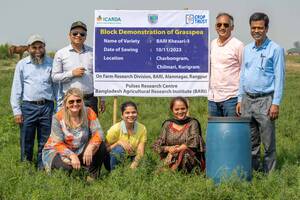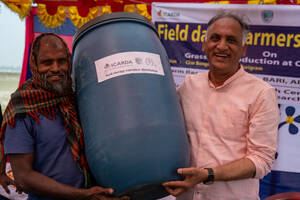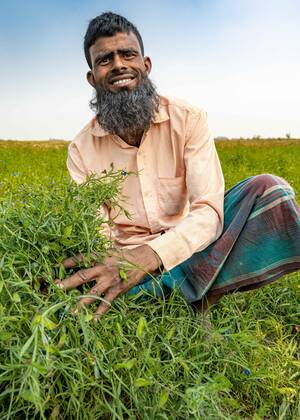Bangladesh’s Char areas, situated within the vast delta formed by the Ganges-Brahmaputra-Meghna rivers, encompass approximately 0.83 million hectares of land. These dynamic landscapes undergo constant changes due to river erosion and deposition, presenting challenges such as flooding and soil salinity. In these regions, where farmers livelihoods are hard to sustain, the cultivation of grasspea has emerged as a beacon of hope.
This versatile and resilient legume crop holds immense agricultural potential because it can thrive in challenging conditions such as drought, waterlogging, extreme temperatures and requires minimal external inputs and providing a low-cost source of protein when most other crops fail. Its ability to serve as nutritious food source for human consumption, the fact that it is a valuable fodder for livestock and its contribution to soil fertility through nitrogen fixation makes it a highly versatile and beneficial crop. Grasspea has the ability to revolutionize agriculture in the vulnerable yet resilient regions of Bangladesh and beyond, providing opportunities for resilient farming practices and community adaptation.
ICARDA’s research focuses on harnessing the potential of grasspea in this region with low-quality soil and water scarcity, offering a valuable opportunity for sustainable agriculture and nutritional security for resource-constrained farmers and consumers. In this context, ICARDA, together with scientists from the Bangladesh Agricultural Research Institute (BARI) and the Crop Trust, organized a Farmers’ Field Day at Charbongram, Chilmari (a subdistrict of Kurigram) on 2 March 2024. The event that was part of the BOLD project (Biodiversity for Opportunities, Livelihoods and Development), provided a platform for dialogue and knowledge exchange of grasspea cultivation.

Photo by Michael Major, Crop Trust
During discussions, the adaptability of grasspea to the challenging environmental conditions of the Char areas, along with its dual benefits as a nutritious food source for human consumption and a valuable livestock fodder, stood out as key highlights. Surprisingly, farmers expressed not only willingness but enthusiasm to grow grasspea, citing its resilience, nutritional value, and economic potential. Its unique ability to flourish in post-rainy season conditions where other crops struggle to survive, low-input requirements and resilience to adverse weather conditions make it an attractive option for farmers seeking sustainable agricultural solutions in the Char areas.

Photos: Michael Major for Crop Trust
In a comprehensive discussion with farmers, ICARDA and BARI scientists addressed the persistent stigma associated with grasspea, particularly concerns related to the presence of the toxin ODAP (β-N-Oxalyl-L-α,β-diaminopropionic acid) and its alleged association with neurological issues, which has hindered its global adoption. However, the farmers confidently dismissed these apprehensions based on their extensive experience, stating that they have exclusively observed positive outcomes from cultivating grasspea. They emphasized that their families have been consuming grasspea for generations without encountering any adverse effects, reinforcing their confidence in the crop’s safety and benefits.

Photo by Michael Major, Crop Trust
The Field Day highlighted once more the immense potential of grasspea to transform agricultural landscapes in Char areas of Bangladesh. It is crucial for policymakers, researchers, and practitioners to collaborate in unlocking the full potential of grasspea cultivation in these regions, fostering lasting positive change.
AUTHORS
Dr. Akanksha Singh, National Associate Scientist, ICARDA
Dr. Shiv Kumar Agrawal, ICARDA’s regional coordinator for South Asia and China and Head of the Food Legumes Research Program
SOURCE
Originally published on icarda.org
PHOTO
© Michael Major, Crop Trust